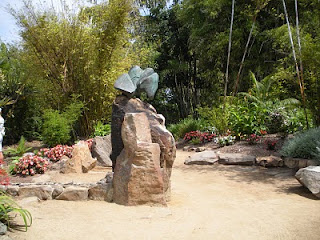
Some folks might think I was a hoarder, since I don't like to throw functional things away. Who knows when I might need something, and if I have stuff stored in a convenient place, it saves me a trip to the hardware store, or wherever. For example, I buy eggs in cardboard cartons. I can use them to start seeds, or rip them up for my compost pile if I need something dry to add in with too much moist waste. A friend of mine who was redoing a bathroom had extra tiles of many sizes. The 4 inch square ones can be broken up and used in mosaic pieces. I used the longer narrow ones as plant markers. Take a sharpie permanent marker, and write the name of the plant on the tile, and just place it into the pot, or glue it onto a popsicle stick and stick it in the soil.
A few other ideas I've used:
--Newspaper can be shredded and used in the compost pile, or as a weed barrier. Place six layers of newspaper on the area, then cover with mulch. As the paper decomposes, it also feeds the soil, and gets rid of weeds at the same time. Worms love to eat the paper, and their castings enrich the soil.
--Wine corks and foam peanuts from packing boxes can be used in the bottom of big pots to keep the soil loose and give the pot good drainage.
--small jars with tight-fitting lids can be used to store seeds, herbs, anything small.
--Old pots can be reused as planter liners, which can be switched out in each season by filling with a new plant.
--A used shower curtain makes a good liner for your trunk or back seat when transporting dirty stuff from the nursery that could spill and mess up your car.
--used nylon panythose can be cut up and used as delicate plant ties.
--plastic silverware can also be used as plant markers.
--I put colorful old bottles in the garden among my plants, for some added color and interest.
 --shells and small stones can be placed on the top of the soil of potted plants to add some interest. You can also put them in a water feature and watch the water cascade over them.
--shells and small stones can be placed on the top of the soil of potted plants to add some interest. You can also put them in a water feature and watch the water cascade over them.--I've seen old toilets, kids cribs or bassinets, even wheel barrows used as planters. Just be sure there is a way for water to drain out, so as not to drown your plants.
--I like going to garage sales and seeing what kind of neat stuff I can find to put in my garden to give it an individual, one of a kind look. Planters, pots, bottles, statues, stands, who knows what might capture my imagination?
When I put in my new landscape, I went around the house to see what kinds of things I might find that could stay outside and add some interest and "funkiness" to my newly-planted space. Stones and shells looked great on my little wall, and the lizards like to hang out around them and do their little push-ups!






